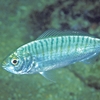General Description
Body very long, slender, head depressed; dorsal fin modified into a flattened sucking disc; pectoral fin pointed, pelvic fin narrowly connected to the body by a membrane, anal fin with 30-38 rays. Dark grey brown to black above, paler below with a dark, often pale-edged midlateral stripe; fins dark to black in adults. Juveniles with pale paired fins and anterior parts of soft dorsal and anal fins and outer margin of caudal fin white. To 1 m.
Biology
Although these remoras usually attach themselves to larger fishes and other marine animals, they may also be free swimming. They feed on smaller fishes and zooplankton.
Habitat
Pelagic in tropical and subtropical coastal waters of all major oceans, in depths of 0-200 m.
Open water
Distribution guide
All majors oceans.
Species Group
Depth
Shore (0-1 m)
Shallow (1-30 m)
Deep ( > 30 m)
Water Column
Max Size
1 m
Commercial Species
No
Global Dispersal
Recorded in Australia
Conservation Status
- DSE Advisory List : Not listed
- EPBC Act 1999 : Not listed
- IUCN Red List : Not listed





